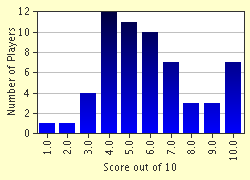Quiz Answer Key and Fun Facts
1. What exactly is a Parish?
2. The start of the Victorian era is usually taken as the basis for denoting the ancient parishes of England. Roughly how many parishes were there in England at that time?
3. What is the word that means "to do with a parish"?
4. What is NOT a kind of information for which parish registers were created?
5. When did parish registers start?
6. Sometimes in a parish a second church might be built to cope with bigger congregations and for parishioners who lived a distance from the original church. What was such a church called?
7. Where are most original parish registers kept - those not currently in use, that is?
8. Originally parish register entries were written on blank pages. When did the first printed registers come into use?
9. From what date did all parish registers consist of preprinted bound volumes?
10. Between 1754 and 1837 all marriages had to be in a Church of England church, except for:...?
Source: Author
DaveJacobs
This quiz was reviewed by FunTrivia editor
Moo before going online.
Any errors found in FunTrivia content are routinely corrected through our feedback system.

